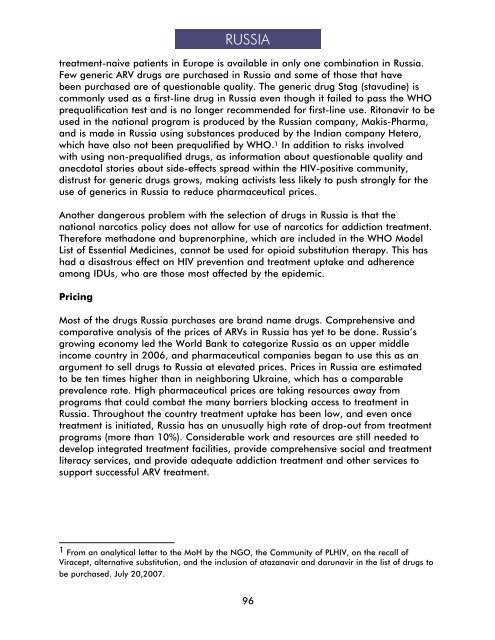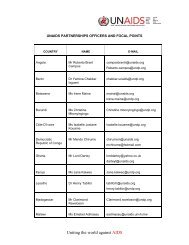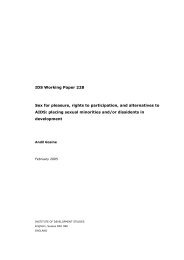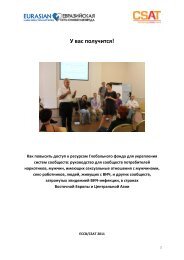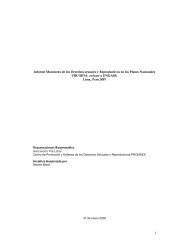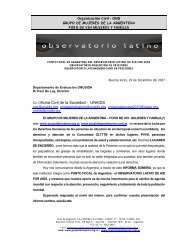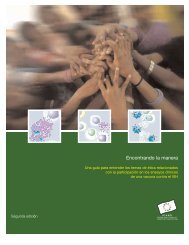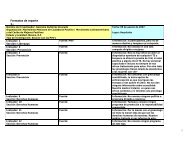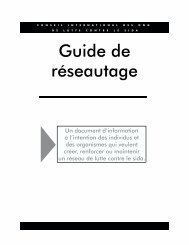Missing the Target #5: Improving AIDS Drug Access ... - CD8 T cells
Missing the Target #5: Improving AIDS Drug Access ... - CD8 T cells
Missing the Target #5: Improving AIDS Drug Access ... - CD8 T cells
You also want an ePaper? Increase the reach of your titles
YUMPU automatically turns print PDFs into web optimized ePapers that Google loves.
treatment-naive patients in Europe is available in only one combination in Russia.Few generic ARV drugs are purchased in Russia and some of those that havebeen purchased are of questionable quality. The generic drug Stag (stavudine) iscommonly used as a first-line drug in Russia even though it failed to pass <strong>the</strong> WHOprequalification test and is no longer recommended for first-line use. Ritonavir to beused in <strong>the</strong> national program is produced by <strong>the</strong> Russian company, Makis-Pharma,and is made in Russia using substances produced by <strong>the</strong> Indian company Hetero,which have also not been prequalified by WHO. 1 In addition to risks involvedwith using non-prequalified drugs, as information about questionable quality andanecdotal stories about side-effects spread within <strong>the</strong> HIV-positive community,distrust for generic drugs grows, making activists less likely to push strongly for <strong>the</strong>use of generics in Russia to reduce pharmaceutical prices.Ano<strong>the</strong>r dangerous problem with <strong>the</strong> selection of drugs in Russia is that <strong>the</strong>national narcotics policy does not allow for use of narcotics for addiction treatment.Therefore methadone and buprenorphine, which are included in <strong>the</strong> WHO ModelList of Essential Medicines, cannot be used for opioid substitution <strong>the</strong>rapy. This hashad a disastrous effect on HIV prevention and treatment uptake and adherenceamong IDUs, who are those most affected by <strong>the</strong> epidemic.PricingRUSSIAMost of <strong>the</strong> drugs Russia purchases are brand name drugs. Comprehensive andcomparative analysis of <strong>the</strong> prices of ARVs in Russia has yet to be done. Russia’sgrowing economy led <strong>the</strong> World Bank to categorize Russia as an upper middleincome country in 2006, and pharmaceutical companies began to use this as anargument to sell drugs to Russia at elevated prices. Prices in Russia are estimatedto be ten times higher than in neighboring Ukraine, which has a comparableprevalence rate. High pharmaceutical prices are taking resources away fromprograms that could combat <strong>the</strong> many barriers blocking access to treatment inRussia. Throughout <strong>the</strong> country treatment uptake has been low, and even oncetreatment is initiated, Russia has an unusually high rate of drop-out from treatmentprograms (more than 10%). Considerable work and resources are still needed todevelop integrated treatment facilities, provide comprehensive social and treatmentliteracy services, and provide adequate addiction treatment and o<strong>the</strong>r services tosupport successful ARV treatment.1 From an analytical letter to <strong>the</strong> MoH by <strong>the</strong> NGO, <strong>the</strong> Community of PLHIV, on <strong>the</strong> recall ofViracept, alternative substitution, and <strong>the</strong> inclusion of atazanavir and darunavir in <strong>the</strong> list of drugs tobe purchased. July 20,2007.96


